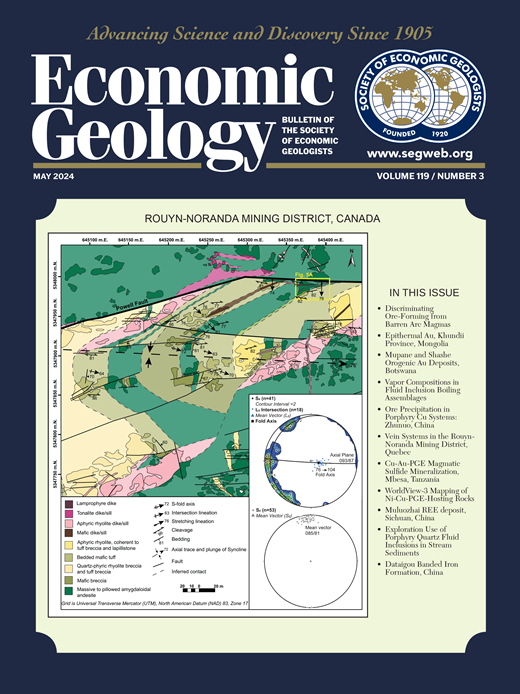A Model for the Lithospheric Architecture of the Central Andes and the Localization of Giant Porphyry Copper Deposit Clusters
IF 4.9
1区 地球科学
Q1 GEOCHEMISTRY & GEOPHYSICS
引用次数: 1
Abstract
In the central Andes, giant porphyry copper deposits of similar ages group into discrete geographic clusters that are regularly spaced and aligned within orogen-parallel belts. This clustering highlights how exceptional geologic processes affected localized regions of the lithosphere during mineralization and that the spatial and temporal distribution of giant porphyry deposits is nonrandom. Development of favorable regions of lithosphere for significant metal concentration are linked to the overlap of structural pathways that focus fluid and magma flow from the mantle to upper crust during high-horizontal-compressive-strain events. These structural pathways are notoriously difficult to identify in the field due to their often-subtle surficial manifestations and continental scale. Field mapping at multiple scales in northwest Argentina and southern Peru, as well as regional structural traverses throughout the central Andes, indicates the presence of regional-scale structural corridors 5 to 25 km wide and hundreds of km long that consist of myriad fault planes. The variable width and diffuse surface expression of these corridors is interpreted to reflect the upward propagation of underlying zones of basement weakness through younger supracrustal sequences in the overriding plate. Such structural corridors are (1) apparent at multiple scales of investigation, (2) long-lived, (3) preferentially reactivated though time, and (4) evident in geophysical data sets. This structural architecture formed in response to the interplay of pre-Cenozoic tectonics and the orientation of inherited structural weaknesses. These fault systems persist in the upper crust as steep zones of enhanced permeability that can preferentially reactivate as pathways for ascending hydrous magmas and fluids during major deformation events. Linear orogen-parallel structural belts cogenetic with the magmatic arc provide the first-order control to giant porphyry copper deposit distribution. The second-order control is the intersection of orogen-oblique structural corridors with the orogen-parallel belts, localizing deposit clusters at these intersections. Such regions are inferred to have been zones of deep permeability, with vertical translithospheric pathways activated during high-strain tectonic events that affected the intra-arc stress field.安第斯山脉中部岩石圈构造模型与巨型斑岩型铜矿群的定位
在安第斯山脉中部,年龄相近的巨型斑岩铜矿在造山带平行带内有序地排列成离散的地理集群。这种聚类突出了异常的地质过程在成矿过程中如何影响岩石圈的局部区域,以及巨型斑岩矿床的时空分布是非随机的。岩石圈有利金属富集区域的发育与构造路径的重叠有关,这些构造路径在高水平压缩应变事件中使流体和岩浆从地幔流向上地壳。众所周知,这些构造路径由于其通常微妙的表面表现和大陆规模而难以在野外识别。在阿根廷西北部和秘鲁南部进行的多尺度野外测绘,以及整个安第斯山脉中部的区域构造穿越,表明存在5至25公里宽、数百公里长的区域尺度构造走廊,这些走廊由无数的断平面组成。这些走廊的变宽度和漫反射面表现反映了基底软弱下伏带在上覆板块中通过较年轻的上地壳层序向上传播。这样的构造走廊(1)在多个调查尺度上都很明显,(2)寿命长,(3)随着时间的推移优先重新激活,(4)在地球物理数据集中很明显。这种构造结构是前新生代构造和遗传构造弱点取向相互作用的结果。这些断裂系统在上地壳中持续存在,成为渗透性增强的陡峭地带,在重大变形事件中,它们可以优先重新激活,成为含水岩浆和流体上升的通道。与岩浆弧共生的线状造山带-平行构造带对巨型斑岩型铜矿床的分布具有一级控制作用。二级控制是造山斜构造廊与平行造山带的交点,在这些交点定位矿床簇。这些区域被推断为深渗透带,在高应变构造事件期间,影响弧内应力场的垂直跨岩石圈通道被激活。
本文章由计算机程序翻译,如有差异,请以英文原文为准。
求助全文
约1分钟内获得全文
求助全文
来源期刊

Economic Geology
地学-地球化学与地球物理
CiteScore
10.00
自引率
6.90%
发文量
120
审稿时长
6 months
期刊介绍:
The journal, now published semi-quarterly, was first published in 1905 by the Economic Geology Publishing Company (PUBCO), a not-for-profit company established for the purpose of publishing a periodical devoted to economic geology. On the founding of SEG in 1920, a cooperative arrangement between PUBCO and SEG made the journal the official organ of the Society, and PUBCO agreed to carry the Society''s name on the front cover under the heading "Bulletin of the Society of Economic Geologists". PUBCO and SEG continued to operate as cooperating but separate entities until 2001, when the Board of Directors of PUBCO and the Council of SEG, by unanimous consent, approved a formal agreement of merger. The former activities of the PUBCO Board of Directors are now carried out by a Publications Board, a new self-governing unit within SEG.
 求助内容:
求助内容: 应助结果提醒方式:
应助结果提醒方式:


